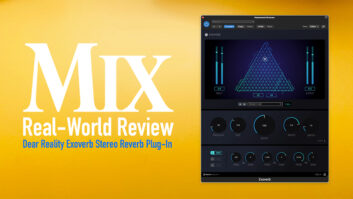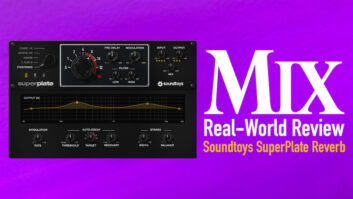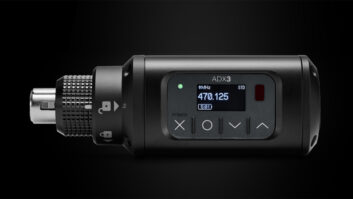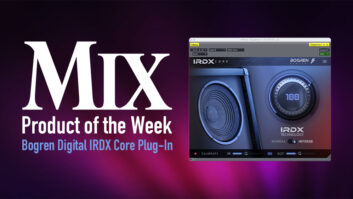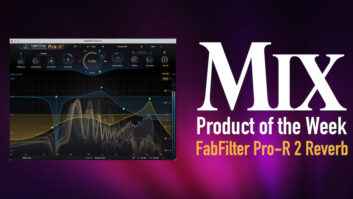

Designed by Tony Agnello, the Eventide original SP2016 digital reverb was stellar for its day. The name referred to SP for signal processor and 2016 for its 20kHz bandwidth (40kHz sampling rate) and 16-bit converter resolution. It stood toe-to-toe with other reverbs of its day — from AMS to Lexicon — and quickly became a favorite for many engineers.
Agnello has re-developed the unit with a new look and a new company (Princeton Digital, distributed by Eventide) while maintaining all of the quality that users loved about the original.
Being an SP2016 fan, I was anxious to get my hands on the reissue to see how it compared to my vintage unit. The Reverb 2016 ($2,245 list, below $1,800) is deftly executed in a single rackspace. Balanced XLR and TRS stereo analog I/O is provided, as is co-ax S/PDIF I/O (44.1/48 kHz downsampled to 40 kHz). The downsampling is intentional to re-create the same sonic character as the original. The back also carries a TRS footswitch jack (for kill and bypass), MIDI I/O, +4/-10 input switch and a standard IEC AC receptacle.
The front has stereo meters, each with four multicolor LEDs, and another as a clip indicator. There are input and output rotary controls with a mono LED indicating when the algorithm only accepts a mono input. Next is a digital-in switch, which kills the input to the algorithm (to isolate the reverb tail) and a relay bypass switch. The seven parameters each have their own dedicated rotary, which is a vast improvement over the search/execute/slide approach of old. Parameters include mix, pre-delay, decay, front/rear, diffusion and low/high EQ. Next to that is the algorithm choice control with a new blue LED indicating if you’re into the enhanced versions. Next to the highly readable, three-figure numeric readout are the System and Save buttons, a rotary for scrolling through the 99 user-assignable presets and a power switch.
The system parameters allow you to access the MIDI dump and load functions, set the MIDI channels and check the software version. More importantly, this is where you can set the unit so it mults the left analog input across both the left and right inputs to the algorithm — a nice feature that is carried over from the original.
OLD AND NEW DUKE IT OUT
For source material, I used vocals, acoustic guitar and drums from a Pro Tools|HD session at 44.1 kHz/24-bit. I listened back through Westlake Lc5.75 monitors powered by a Hafler 9505 amp. Initially, I listened to the unit by itself using the digital and analog I/O. It performed well in all situations. Like the original, the reverb sits well in the track, but unlike the original, which can be temperamental and a pain to surf through, the interface is wonderful to use.
The fun came when I set up the A/B test between the Reverb 2016 and my original unit. For this test, I took the source material out of the stereo bus so I could hear just the reverb. I ran my source tracks through separate buses to the inputs of both units and put the returns side-by-side for easy A/B comparison. I first compared the room reverb algorithms on both units, with all parameters set for identical reverb times, front-to-back settings and pre-delay. Sonically, both units were dead-on.
Next, I moved on to stereo room. This algorithm opens up more of the interface for tweaking, adding diffusion and two bands of sweepable EQ. I matched both units to my favorite settings: EQ at -3 at 250 Hz and -1 at 5k. Once again, it was spot-on — so much so that I found myself pushing the Kill button on the new unit and the Disable button on the old one to reassure myself that I hadn’t somehow patched the same output through to the same returns.
The last comparison was on the plate setting. Once again, after adjusting levels and adjusting the parameters to the same settings, it was virtually identical.
The new algorithms are enhanced versions of the three basic algorithms and were outstanding in their own right. I honestly wish Agnello hadn’t stopped at just the three main effects, but went on to re-create his multitap delay, gated reverb and RMX Simulator, which are all fantastic. Maybe for a later software upgrade?
The new SP2016 gets high marks for execution, style and sound. The interface is very well done: Knobs are tight and windows and LEDs are easily readable from across the room. Sonically, the unit is right on the money. Anyone putting up with the idiosyncrasies of their old unit will gladly upgrade and turn the original into a boat anchor. Although the MIDI implementation and footswitch for kill and bypass is nice, I wish the unit, like the original, had a dedicated remote control, either wired or not.
Sure, it’s a one-trick pony, but how often do you use one or two favorite ‘verbs on your do-everything box? Other than that, nothing more can be said except, “Tony, you got this one right.”
Princeton Digital, dist. by Eventide, 201/641-1200, www.eventide.com.
Kevin Becka is Mix‘s technical editor.

• Want to know more about the original Eventide SP2016? Click
here.

